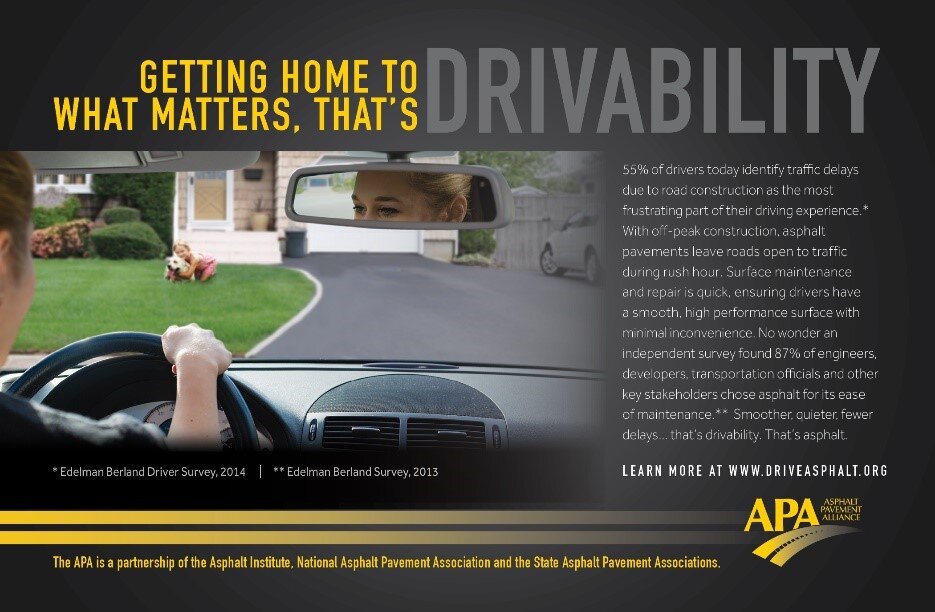
Asphalt
Upcoming Webinars
The APA and its partners offer webinars throughout the year on a variety of topics related to the asphalt industry. With knowledgeable presenters from around the county, these webinars are dedicated to teaching best practices for testing, design, and application of asphalt delivered to you in the comfort of your home or office.
WEBINAR
2:00 PM – 3:30 PM EDT
OCT. 7, 2021
Beyond the Basics: Mechanistic-Empirical Pavement Design
WEBINAR
2:00 PM – 3:30 PM EDT
OCT. 13, 2021
Perpetual Pavements by Conversion
WEBINAR
2:00 PM – 3:30 PM EDT
OCT. 27, 2021
Beyond the Basics: Plant Operations—Calibrations & Verifications
WEBINAR
2:00 PM – 3:30 PM EDT
NOV. 4, 2021
Beyond the Basics: Jobsite Layout & Preparation: Pre-Planning
Welcome to PAVExpress
A free, simplified pavement design tool for flexible and rigid pavements using AASHTO 93/98.
http://www.pavexpressdesign.com
PaveInstruct gives you detailed instruction of the PaveXpress Design Software:
http://paveinstruct.com
PerRoad Software
Perpetual Pavement Design Software
The APA offers two versions of its software for the design and analysis of Perpetual Pavements. Both versions of the software are available as free downloads.
PerRoad 4.3
PerRoad is uses the mechanistic-empirical design philosophy. The program couples layered elastic analysis with a statistical analysis procedure (Monte Carlo simulation) to estimate stresses and strains within a pavement. Version 4.3 provides design results as percentile responses and as conventional designs with transfer functions. In order to predict strains that would prove detrimental for fatigue cracking or structural rutting. PerRoad requires the following inputs:
Seasonal pavement moduli and annual coefficient of variation (COV)
Seasonal resilient moduli of unbound materials and annual COV
Thickness of bound materials and COV
Thickness of unbound materials
Load spectrum for traffic
Location for pavement response analysis
Magnitude of limiting pavement responses
Transfer functions for pavement responses exceeding the user-specified level for accumulating damage
PerRoadXpress 1.0
PerRoadXpress is an easy-to-use, all-on-one-screen program for designing Perpetual Pavements for low- and medium-volume roads and parking lots. The designer chooses a type of asphalt cement. PerRoadXpress then allows the designer either to use defaults for traffic and soil, or to input the actual values if they are known. Granular base thicknesses from 0 to 10 inches are included. The software quickly provides the user with a recommendation for the total thickness of asphalt pavement needed for a particular situation. PerRoadXpress was developed in response to requests by public works officials and owners of commercial property.
Over the last 3 or 4 years, it seems that many of the talks I give or topics that consultants, engineers, and developers want to hear about revolves around green construction practices. Whether it is Warm Mix Asphalt, utilizing Recycled Asphalt Pavements (RAP), Porous Pavements or other methods to reduce waste or increase sustainability, “Green” applications are all the rage.
Can asphalt help toward LEED Certification? It certainly can. Immediately when you think about a building and sustainability you consider insulation, the glass, what kind of roof will be utilized, the heating and ventilation system. The site that the building is on can be secondary when looking at the big picture. Maybe it shouldn’t be secondary when you can gain multiple LEED credits through the many applications that the asphalt industry has to offer development projects.
Sustainable Sites (SS) discourages development on previously undeveloped land and encourages minimizing the impact of the development on the ecosystem and waterways. This category just seems like it was written for porous asphalt pavements. SS Credit 6.1 and SS Credit 6.2 relate to stormwater quantity and quality. By reducing the amount of impervious surfaces on a developed site, porous asphalt can get credit for Stormwater Design for both Quantity and Quality. Porous asphalt helps to reduce site stormwater discharge and infiltration of runoff has the highest pollutant removal efficiency of many possible options.
The Materials and Resources (MR) category promotes the reduction of waste as well as encouraging the reuse and recycling of materials generated both on and off the construction site. Asphalt pavements are 100% recyclable. In fact asphalt is the most recycled product in the United States. So any asphalt that is already in place on a particular site can be delivered back to the plant and reused in the fresh asphalt for the project. A project can get LEED credits for this reuse along with reducing the demand for virgin materials. For example a project that reuses 5 to 10% of all site materials can gain 1 or 2 credits for this category. Recycling the asphalt pavements can make these credits readily achievable.
LEED Credits: Green Asphalt
| Category | Description | Pavement Type | Credits |
|---|---|---|---|
| SS Credit 6.1 | Stormwater Design: Quantity Control | Porous Asphalt | 1 |
| SS Credit 6.2 | Stormwater Design: Quality Control | Porous Asphalt | 1 |
| SS Credit 7.X | Heat Island Effect: Non-Roof | Reflective Surfaces Open-graded asphalt Porous Asphalt | 1 to 3 |
| MR Credit 2.X | Construction Waste Management: Divert from Disposal | RAP in Mix | 1 to 2 |
| ID Credit 1.X | Exceptional Performance | Warm-Mix High-RAP mixes | 1 to 4 |
Hot Mix Asphalt Pavements
Fast Facts
Pavements constructed of Hot Mix Asphalt (HMA) are so versatile that they can be used in practically every situation. Consider these examples of the versatility of HMA pavements:
In parking lots, HMA pavements are durable and economical.
On interstate highways, HMA pavements stand up to high speeds and heavy trucks.
In ports and log yards, new types of heavy-duty HMA pavements stand up to static loads.
On city streets, HMA pavements are cost-effective, durable, safe, and quiet.
When building a new neighborhood or shopping center, staged construction can be used to provide a durable pavement during construction, and then topped with a pristine layer of asphalt for a beautiful street that will last for many years.
The driving surface of an HMA pavement can be customized to
eliminate rutting
increase skid resistance
lower the risk of hydroplaning
decrease splash and spray
absorb noise
Environmental benefits
Asphalt pavement is America’s most recycled product. And asphalt pavements have many environmental uses, including:
liners for reservoirs and fish hatcheries,
caps for landfills, and
biking/hiking trails that enhance our access to the outdoors while reducing damage to fragile ecosystems.
New technology
HMA offers state-of-the-art technology. New, specially designed pavement types include Superpave, SMA
(Stone Matrix Asphalt), OGFC (Open Graded Friction Course), high-modulus HMA, dense-graded HMA, HMA with modified binders, thin lifts pavements, porous asphalt pavements, warm mix asphalt (WMA), to name a few.
Easy maintenance
HMA pavements are easy to preserve and maintain because the top layer can be milled off for recycling, then replaced with a new, durable pavement. On commuter routes, all the work can be done overnight, so that most motorists are not inconvenienced by construction delays.






